Prince
Obolensky / Cromwell Square
"A sporting
icon, the Prince came from St Petersburg as a baby when his family fled
the Russian Revolution in 1917. An Oxford graduate, Obolensky became a
naturalised Englishman. He died near Ipswich at only 24." Thus runs the
text on the plaque beneath the man's name carved in best chiselled
characters in the stone.
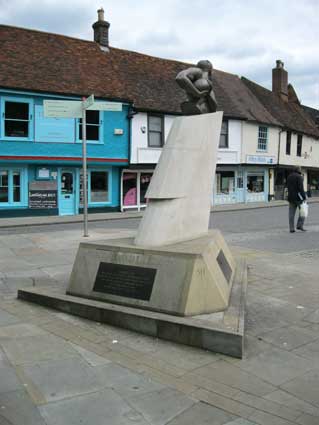

This stone and bronze sculpture by Harry Gray was placed in Cromwell
Square in 2009. In the background of image 1 (above) are shops and
restaurants in St Nicholas Street.
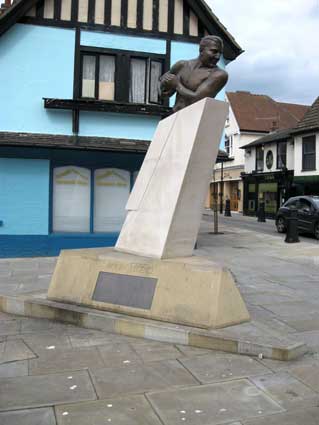
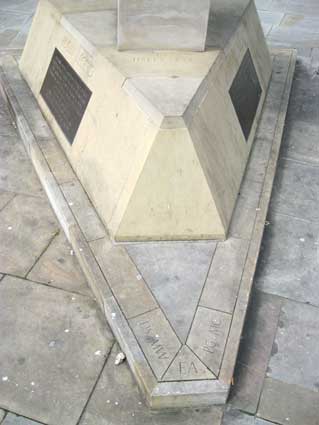
Prince Alexander studied at Oxford University where he played Rugby
football, gained a 'blue' and went on to play for Leicester and
England. He played for Leicester Tigers between 1934 and 1939 at wing
three-quarter back. His selection for England caused a stir because he
was not English but gained British citizenship in 1936. In 1936 he
scored two tries in a 13 - 0 victory over the All Blacks. He only won
four caps for England but his name entered into legend because of
television coverage of his tries and the manner in which he was killed.
He was killed during the Battle of Britain when his Hawker Hurricane
crashed on Martlesham Heath near Ipswich while training in 1940. He was
24 years old. He is buried in Ipswich Cemetery.
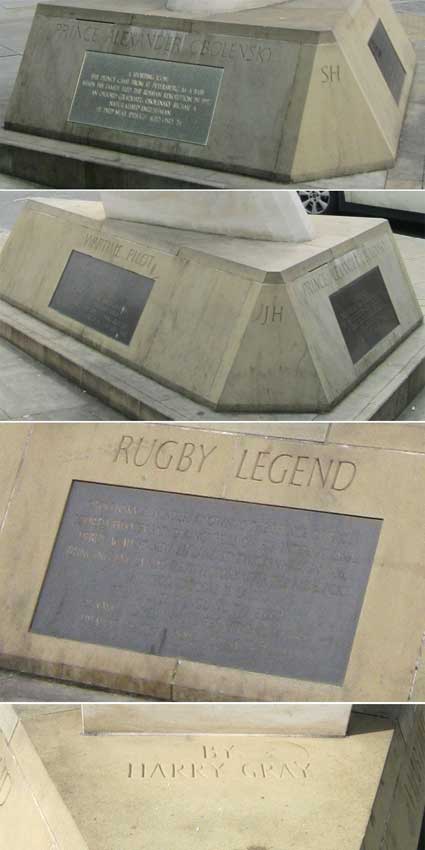 The details
of the triangular plinth show
that it embodies a variety of lettering cut into the stone. From top to
bottom:
The details
of the triangular plinth show
that it embodies a variety of lettering cut into the stone. From top to
bottom:
'PRINCE ALEXANDER OBOLENSKY'
'JH'
'WARTIME PILOT'
'RUGBY LEGEND'
'SH'
'BY
HARRY GRAY'
With around the point of the lower pavement:
'DS MW
EA
PG MC'
This is how
the Daily
Telegraph's Brendan
Gallagher (18.2.2009) reported the unveiling of the sculpture:
'An unlikely, but entirely agreeable, collaboration between Daily
Telegraph readers, Chelsea owner Roman Abramovich and the town of
Ipswich came to fruition on Wednesday when a sculpture of Russian
prince and England rugby great Alexander Obolensky was unveiled in the
Suffolk town.
There is more than a touch of the "Heroic worker" in Harry Gray's
iconic and ironic bust that now dominates Cromwell Square –
as a 'white Russian', Prince Obolensky and his family fled the country
to escape the revolution.
The Obolensky story is not new, but its retelling in The Daily
Telegraph in 2006 struck a chord with a new generation, exactly 70
years after he scored two of the most stunning tries ever seen at
Twickenham to help England defeat the All Blacks, although the
19-year-old Oxford undergraduate was famously not a British passport
holder at that time.
In 1940, aged 24, he became the first rugby international to be killed
in World War Two, losing his life to a bizarre training accident in his
Hawker Hurricane at Martlesham Heath, just outside Ipswich, where he
was based with 504 squadron.
As he taxied in his Hurricane, the wheels were caught in a rabbit
warren and, not wearing a harness, as was the habit of Hurricane pilots
when taxiing because of visibility issues, he was catapulted out and
broke his neck.
James Hehir, the chief executive of the borough council, was surprised
to learn that the Russian prince who had played and died for his
naturalised country was buried in Ipswich cemetery and felt Obolensky
should be honoured with a statue – as are other Ipswich
notables such as cartoonist Giles, Sir Bobby Robson and Sir Alf Ramsey.
In no time Telegraph readers were sending in their donations, along
with local businessman Graeme Kalbraier and, when he heard of the
project, Chelsea's Russian owner, Abramovich.
Obolensky remains an enduringly exotic figure, part David Duckham with
a title, part James Dean in rugby boots.
Rarely seen without a beautiful society girl on his arm –
indeed a number of ladies of a certain age rushed to make donations to
the project – he would down a dozen oysters and sip champagne
before a big game and had a pair of lightweight boots specially made to
maximise his speed.
He lived fast, died young and his memory lives on.'
The £50,000 statue was unveiled on 18 February 2009 by the
Prince's niece, Princess Alexandra Obolensky.
The Public Sculpture of Norfolk & Suffolk website (see Links) tells us:-
The full inscriptions:
"RUGBY LEGEND; Obolensky, a winger, known as the Prince of Pace scored
two ‘breathtaking’ tries on his international debut against New Zealand
in 1936 bringing England’s first victory over the All Blacks. His
second score is called ‘the greatest England try ever’. He once played
in an international Rugby trial at Portman Road Football club.
WARTIME
PILOT; A volunteer RAF pilot in the Second World War, Obolensky’s life
was cut short when his Hurricane fighter crash-landed at Martlesham
Hearth in 1940. Obolensky is buried in Ipswich Cemetery. The tribute on
the grave reads: ‘His undaunted spirit and endearing qualities live
forever in the hearts of all who knew him.’
PRINCE ALEXANDER OBOLENSKY A sporting Icon. The Prince came from St
Petersburg as baby when his family fled the Russian Revolution in 1917.
An Oxford Graduate, Obolensky became a naturalised Englishman. He died
near Ipswich aged only 24.
What makes the sculpture remarkable is its success in combining a
figurative memorial with telling design. The plinth is broken at the
back to create an interesting rhythm and angled forward and up to
suggest the sleek aerodynamic designs of the 1930s as well as the
forward thrust of Obolensky’s great Twickenham try, translated into
heroic terms in the bronze, where bare-chested he holds the ball behind
him, his profile and swept hair a heroic version of the man shown in
contemporary photographs. The plinth has another function, in allowing
for the bronze plaques which record a life and achievements not widely
appreciated."
Below: a close-up of the Obolensky bust, in spite of the bird-droppings.
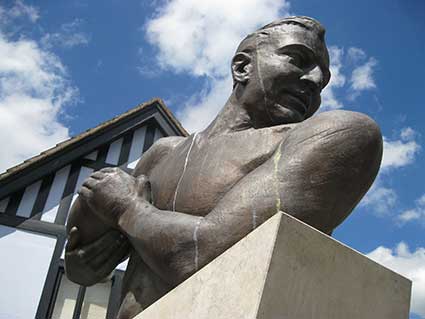 2018 image
2018 image
Cromwell Street/Square
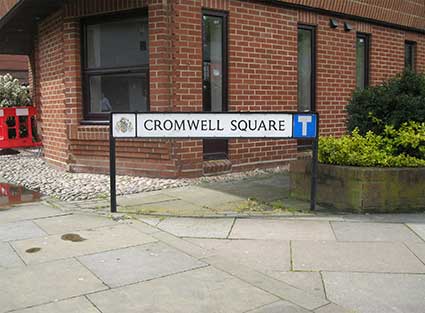 2019 images
2019 images
Above: the street nameplate opposite the
Obolensky sculpture. The brick building behind it is Saxon House, part
of the developments here following the demolition of the south side of
Cromwell Street in the 1960s. For the story, see 'the Ring-Road that
never was' on our Ipswich tomorrow
page.
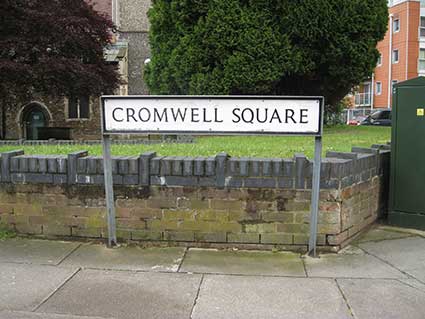

The second street nameplate is further south on the same side; the
north walls of St Nicholas Church are behind it.
Many people assume that this area is named after Oliver Cromwell,
who dominated the short-lived Commonwealth of England as a member of
the Rump Parliament (1649–1653). However, there is no evidence that
Oliver Cromwell ever visited Ipswich. The Cromwell who did have ties to Ipswich, via his
mentor Thomas Wolsey, was Thomas Cromwell, who is increasingly
better-known following the novels of Hilary Mantel documenting the
marriages of Henry VIII. Following the fall from grace of Wolsey,
Cromwell managed to step into the Cardinal's shoes and maintain the
favour of Henry VIII (no mean feat). Cromwell was instrumental in
saving the Ipswich Grammar School, securing its future, and returning
the Church of St Peter to its parishioners – Wolsey had earlier
sequestered the church to serve as the chapel of his College.
See our pages on:
Christ's Hospital School;
Wolsey's College;
Street name derivations;
for further information.
Home
Please email any comments
and contributions by clicking here.
Search Ipswich
Historic Lettering
©2004
Copyright
throughout the Ipswich
Historic Lettering site: Borin Van Loon
No reproduction of text or images without express written permission





 The details
of the triangular plinth show
that it embodies a variety of lettering cut into the stone. From top to
bottom:
The details
of the triangular plinth show
that it embodies a variety of lettering cut into the stone. From top to
bottom:  2018 image
2018 image 2019 images
2019 images
